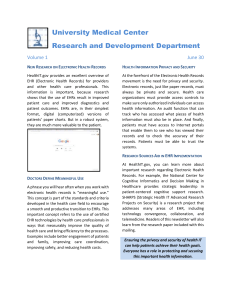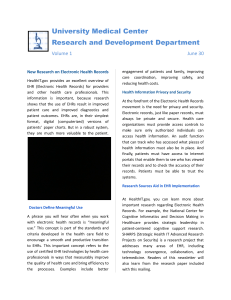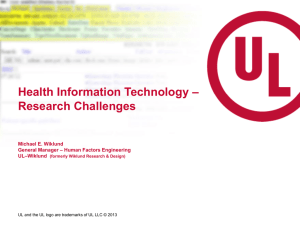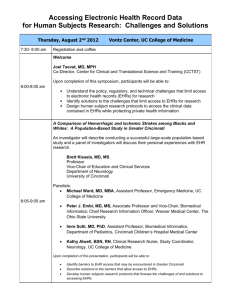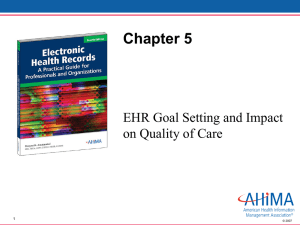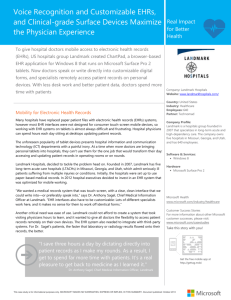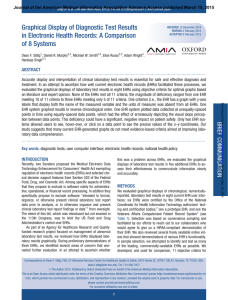impact of electronic..
advertisement
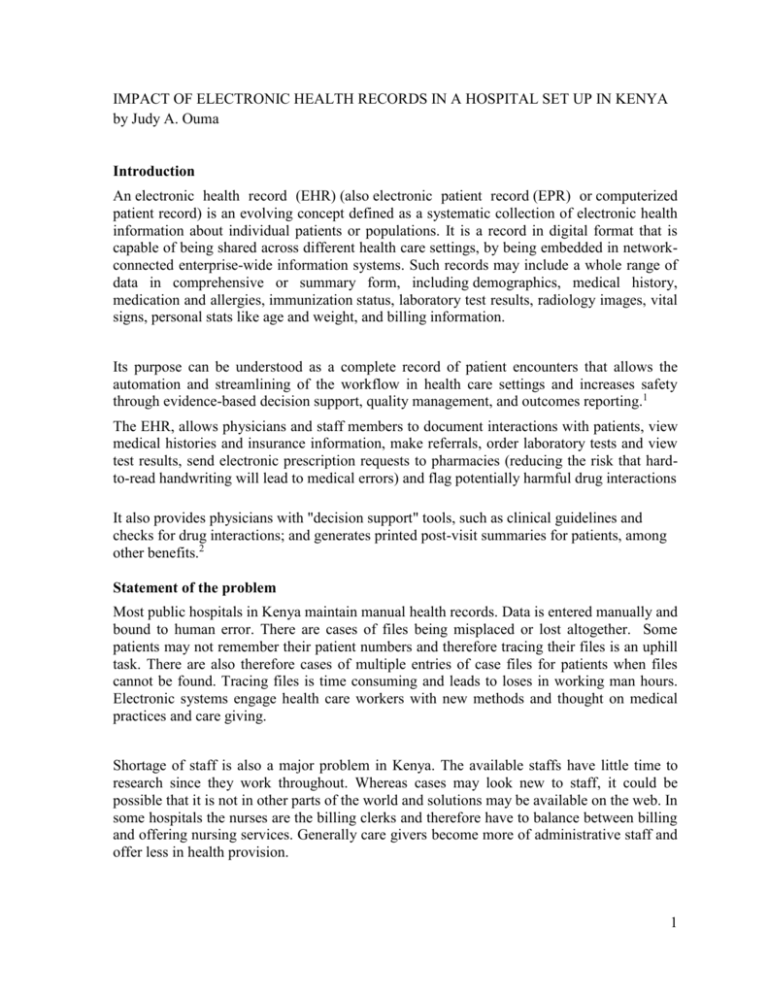
IMPACT OF ELECTRONIC HEALTH RECORDS IN A HOSPITAL SET UP IN KENYA by Judy A. Ouma Introduction An electronic health record (EHR) (also electronic patient record (EPR) or computerized patient record) is an evolving concept defined as a systematic collection of electronic health information about individual patients or populations. It is a record in digital format that is capable of being shared across different health care settings, by being embedded in networkconnected enterprise-wide information systems. Such records may include a whole range of data in comprehensive or summary form, including demographics, medical history, medication and allergies, immunization status, laboratory test results, radiology images, vital signs, personal stats like age and weight, and billing information. Its purpose can be understood as a complete record of patient encounters that allows the automation and streamlining of the workflow in health care settings and increases safety through evidence-based decision support, quality management, and outcomes reporting.1 The EHR, allows physicians and staff members to document interactions with patients, view medical histories and insurance information, make referrals, order laboratory tests and view test results, send electronic prescription requests to pharmacies (reducing the risk that hardto-read handwriting will lead to medical errors) and flag potentially harmful drug interactions It also provides physicians with "decision support" tools, such as clinical guidelines and checks for drug interactions; and generates printed post-visit summaries for patients, among other benefits.2 Statement of the problem Most public hospitals in Kenya maintain manual health records. Data is entered manually and bound to human error. There are cases of files being misplaced or lost altogether. Some patients may not remember their patient numbers and therefore tracing their files is an uphill task. There are also therefore cases of multiple entries of case files for patients when files cannot be found. Tracing files is time consuming and leads to loses in working man hours. Electronic systems engage health care workers with new methods and thought on medical practices and care giving. Shortage of staff is also a major problem in Kenya. The available staffs have little time to research since they work throughout. Whereas cases may look new to staff, it could be possible that it is not in other parts of the world and solutions may be available on the web. In some hospitals the nurses are the billing clerks and therefore have to balance between billing and offering nursing services. Generally care givers become more of administrative staff and offer less in health provision. 1 Justification of the problem In Kenya, with the funding for the health sector keeps dwindling, as a result, hospitals have to consider efficiency and effectiveness if they are to keep afloat. They may need to consider measures that assist health workers come up with appropriate methods for health care delivery. Upon arrival at the hospital the first point of contact is the records section where files are kept. There time taken here can vary depending on the information given by the client and the physical position of the file. In the event that it is lost more waiting time is required. A patient has to move back and forth different departments and physically wait for their results. Therefore whereas nurses and doctors greatly benefit from of EHR, patients are the greatest beneficiaries. Literature Review The electronic health record (EHR) provides the opportunity for healthcare organizations to improve quality of care and patient safety. “The greatest challenge in the new world of integrated healthcare delivery is to provide comprehensive, reliable, relevant, accessible, and timely patient information to each member of the healthcare team, whether in primary or secondary care and whether a doctor, nurse, allied health professional, or patient/consumer” (Schloeffel et al. 2).3 There are multiple advantages in using EHRs. Electronic health records (EHRs) have emerged as a major topic in health care. Several studies have been done on the impact of EHR have added weight to both sides of the debate. There are indeed advantages with the use of EHRs. These include improve quality of care. The implementation of electronic health records (EHR) can help lessen patient sufferance due to medical errors and the inability of analysts to assess quality. Information Technology is being used today to automate day-to-day processes, thus helping to reduce administration costs which then in turn can free up time and money for patient care. EHR systems can help reduce medical errors by providing healthcare workers with decision support. Fast access to medical literature and current best practices in medicine are hypothesized to enable proliferation of ongoing improvements in healthcare efficacy.4 Improved usage of EHR is achieved if the presentation on screen or on paper is not just longitudinal, but hierarchically ordered and layered. During compilation while hospitalisation or ambulant serving of the patient, easing to get access on details is improved with browser capabilities applied to screen presentations also cross referring to the respective coding concepts ICD, DRG and medical procedures information. EHRs also promote evidence-based medicine. They provide access to unprecedented amounts of clinical data for research that can accelerate the level of knowledge of effective medical practices. Realistically, these benefits may only be realized if the EHR systems are interoperable and wide spread (for example, national or regional level) so that various systems 2 can easily share information. Also, to avoid failures that can cause injury to the patient and violations to privacy, the best practices in software engineering and medical informatics must be deployed.5 EHR systems have the advantages of being able to connect to many electronic medical record systems. In the current global medical environment, patients are shopping for their procedures. Many international patients travel to US cities with academic research centers for specialty treatment or to participate in Clinical Trials. Coordinating these appointments via paper records is a time-consuming procedure. A study was done by Gill J M et al on the ‘Impact of EHR-based clinical decision support on adherence to guidelines for patients on NSAIDs: a randomized controlled trial.’6 The study felt that electronic health records (EHRs) with clinical decision support hold promise for improving quality of care, but their impact on management of chronic conditions has been mixed. It examined the impact of EHR-based clinical decision support on adherence to guidelines for reducing gastrointestinal complications in primary care patients on nonsteroidal anti-inflammatory drugs (NSAIDs). It concluded that only a small impact of EHR-based clinical decision support for high-risk patients on NSAIDs in primary care offices and added to the growing literature about the complexity of EHR-based clinical decision support for improving quality of care. A study was done to evaluate the interest taken by the health care providers in the electronic medical file and its use within the quality improvement process by Boyer L et al 7. Sixtyseven percent of staff interviewed had a favorable opinion of the electronic medical file. Physicians had more frequent favorable opinions than nurses who considered that electronic medical files cannot capture real nursing activity. Health care providers considered that electronic medical file could be associated with improved quality of care, but two points should be taken into account: the increased documentation time (slow system response, multiple screens, the lack of computer knowledge, the absence of bedside documentation technology...) and dysfunctions in the information processing system. This could have an impact on documentation completeness, and quality and could also lead to a reduction of time devoted to care. As much as there are many benefits of EHRs there are also issues that may that are still controversial. These include the costs of installation and maintenance. The steep price of EHR and provider uncertainty regarding the value they will derive from adoption in the form of return on investment has a significant influence on EHR adoption.8 In addition, doctors do not want to spend the time to learn a new system. Some doctors believe that adopting a system with EHRs could reduce clinical productivity Methodology The Ministry of Medical Services has begun the process of computerizing high volume hospitals. These hospitals will be evaluated to see the impact of introducing EHRs. Data will be collected from these hospitals and evaluated. 3 Results The policy on computerizing hospitals has borne much fruit. This is evidenced by availability of data that can be used for policy planning. Reporting has improved in matters of time. There are rarely cases of lost files and the time taken to locate a file is much shorter now. Patient waiting time, which is the amount spent in the hospital is now reduced. The uptake by clinicians is rather slow since they have not attended many training sessions. Time to learn the system is also limited due to the current workload. Revenue generation has also improved. This proves that there is indeed an impact on the implementation of EHRs and should be used in all public hospitals 4 REFERENCES 1. http://en.wikipedia.org/wiki/Electronic_health_record 2. http://www.pamf.org/ehr/benefits/ 3. http://www.aameda.org/MemberServices/Exec/Articles/spg04/Gurley%20article.pdf 4. Arizona Republic: “Electronic Health Records: About $500 Million at stake in digital move.” Ken Alltucker. March 20, 2011Sfgs 5. Hoffman S, Podgurski, A (Fall 2008). "Finding a Cure; The Case for Regulation and Oversight of Electronic Health Record Systems" (PDF). Harvard Journal of Law & Technology 22 (1): 10 6. http://www.ncbi.nlm.nih.gov/pubmed/21242557 7. http://www.ncbi.nlm.nih.gov/pubmed/19853719 8. RWIF,GWUMC, and IHP Staff: "Health Information Technology in the United States: The Information Base for Progress", Robert Wood Johnson Foundation, George Washington University Medical Center, and Institute for Health Policy, 200 5





